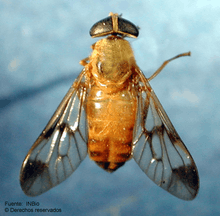Diachlorus ferrugatus
Diachlorus ferrugatus, commonly known as the yellow fly in the United States or doctor fly in Belize, is a species of highly aggressive biting horse-fly of the family Tabanidae native to North and Central America to Costa Rica.
| Diachlorus ferrugatus | |
|---|---|
 | |
| Scientific classification | |
| Kingdom: | |
| Phylum: | |
| Class: | |
| Order: | |
| Suborder: | |
| Infraorder: | |
| Superfamily: | |
| Family: | |
| Subfamily: | |
| Tribe: | |
| Genus: | |
| Species: | D. ferrugatus |
| Binomial name | |
| Diachlorus ferrugatus (Fabricius, 1805) | |
| Synonyms | |
|
Chrysops ferrugatus Fabricius, 1805 | |
Taxonomy
The yellow fly was described as Chrysops ferrugatus by Johan Christian Fabricius in 1805.
Description
Adult yellow flies are around 1 centimetre (0.39 in) long with yellow bodies, mid-and hind-legs, and black fore-legs. The eyes are blue-green with purple bands. They fly with little sound, the first sign of their presence noticed by humans is their bite.[1]
The larvae are thin white grubs with fine yellow fur, each segment having three pairs of pseudopodia.[1]
Distribution and habitat
The yellow fly ranges from the southeastern United States, where it is found from New Jersey to Texas,[1] to Costa Rica.[2] It is most common near bodies of water, along with trees nearby to hide in.[1] Spanish moss (Tillandsia usneoides) is a popular hiding spot.[3]
Effect on humans
It is notorious for its propensity to inflict painful bites on people,[1] having been described as the most aggressive fly species in Florida.[3] The female feeds on blood to develop eggs, and is most active in the summer and early autumn during daylight hours, especially in the late afternoon and on overcast days. Flies can even venture indoors.[1] Its presence affects recreational swimming, boating and fishing from April to June.[3] Yellow fly bites leave itchy welts.[1]
DEET is the most useful insect repellent, though may not prevent bites if the yellow flies are in large numbers. In this case, physical barriers such as gloves and headnets are the only truly effective protection.[1]
References
- G.B. Fairchild; H.V. Weems, Jr. (2014). "Diachlorus ferrugatus (Fabricius) (Insecta: Diptera: Tabanidae)". Featured Creatures: Entomology and Nematology. University of Florida. Retrieved 18 October 2015.
- Brown, Brian Victor (2009). Manual of Central American Diptera. 1. NRC Research Press. p. 505. ISBN 9780660198330.
- Calvin M. Jones; Darrell W. Anthony (1964). The Tabanidae (Diptera) of Florida. U.S. Department of Agriculture. pp. 28–29.